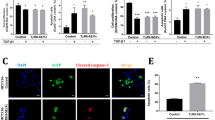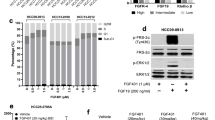Abstract
Inhibition of vascular endothelial growth factor (VEGF) by gene transfer techniques was effectively applied to control experimental tumor growth, whereas effects on systemic VEGF levels had not been investigated. Therefore, we evaluated the effect of VEGF inhibition by adenoviral-mediated gene delivery of a dominant-negative soluble fragment of FLK-1 (sFlk-1) on systemic VEGF levels, organ-specific VEGF-RNA expression and antitumor efficacy in a murine colorectal cancer (CRC) tumor model. Vector function of AdsFlk-1 was shown by Western blot analysis and transgene expression was documented over a time period of 42 days in the serum of treated mice. Although cell supernatant of CT26 cells contained considerable levels of VEGF, systemic VEGF levels in the serum of tumor-bearing mice remained unaffected. Interestingly, mice that were systemically treated with AdsFlk-1 showed a strong upraise of circulating VEGF, whereas VEGF remained at background levels in the control. Vascular endothelial growth factor was increased not only in tumor bearing but also in healthy, tumor-free mice. Vascular endothelial growth factor determination in liver tissue homogenates showed a 16.5-fold upraise in AdsFlk-1-treated animals as compared to the AdLacZ control. Consecutively, systemic small interfering RNA injection targeted against VEGF reverted elevated VEGF levels almost back to normal levels. In spite of elevated VEGF levels, AdsFlk-1 administration showed significant antitumor effects in a subcutaneous metastatic CRC tumor model. There was no significant correlation between antitumour treatment response and VEGF levels in this model. Collectively, we conclude that the systemic administration of AdsFlk-1 had significant inhibitory effects on metastatic CRC tumor growth in spite of elevated systemic VEGF levels and that VEGF serum concentrations did not correlate to tumor burden and antitumor treatment response in this model.
This is a preview of subscription content, access via your institution
Access options
Subscribe to this journal
Receive 12 print issues and online access
$259.00 per year
only $21.58 per issue
Buy this article
- Purchase on Springer Link
- Instant access to full article PDF
Prices may be subject to local taxes which are calculated during checkout







Similar content being viewed by others
References
Hanrahan V, Currie MJ, Gunningham SP, Morrin HR, Scott PA, Robinson BA et al. The angiogenic switch for vascular endothelial growth factor (VEGF)-A, VEGF-B, VEGF-C, and VEGF-D in the adenoma-carcinoma sequence during colorectal cancer progression. J Pathol 2003; 200: 183–194.
Venook A . Critical evaluation of current treatments in metastatic colorectal cancer. Oncologist 2005; 10: 250–261.
Susman E . Bevacizumab adds survival benefit in colorectal cancer. Lancet Oncol 2005; 6: 136.
Cross MJ, Dixelius J, Matsumoto T, Claesson-Welsh L . VEGF-receptor signal transduction. Trends Biochem Sci 2003; 28: 488–494.
Robinson CJ, Stringer SE . The splice variants of vascular endothelial growth factor (VEGF) and their receptors. J Cell Sci 2001; 114 (Part 5): 853–865.
Kuo CJ, Farnebo F, Yu EY, Christofferson R, Swearingen RA, Carter R et al. Comparative evaluation of the antitumor activity of antiangiogenic proteins delivered by gene transfer. Proc Natl Acad Sci USA 2001; 98: 4605–4610.
Tseng JF, Farnebo FA, Kisker O, Becker CM, Kuo CJ, Folkman J et al. Adenovirus-mediated delivery of a soluble form of the VEGF receptor Flk1 delays the growth of murine and human pancreatic adenocarcinoma in mice. Surgery 2002; 132: 857–865.
Becker CM, Farnebo FA, Iordanescu I, Behonick DJ, Shih MC, Dunning P et al. Gene therapy of prostate cancer with the soluble vascular endothelial growth factor receptor Flk1. Cancer Biol Ther 2002; 1: 548–553.
Raskopf E, Dzienisowicz C, Hilbert T, Rabe C, Leifeld L, Wernert N et al. Effective angiostatic treatment in a murine metastatic and orthotopic hepatoma model. Hepatology 2005; 41: 1233–1240.
Bocci G, Man S, Green SK, Francia G, Ebos JM, du Manoir JM et al. Increased plasma vascular endothelial growth factor (VEGF) as a surrogate marker for optimal therapeutic dosing of VEGF receptor-2 monoclonal antibodies. Cancer Res 2004; 64: 6616–6625.
Sato Y, Ajiki T, Inoue S, Fujishiro J, Yoshino H, Igarashi Y et al. Gene silencing in rat-liver and limb grafts by rapid injection of small interference RNA. Transplantation 2005; 79: 240–243.
Zabala M, Wang L, Hernandez-Alcoceba R, Hillen W, Qian C, Prieto J et al. Optimization of the Tet-on system to regulate interleukin 12 expression in the liver for the treatment of hepatic tumors. Cancer Res 2004; 64: 2799–2804.
Kramer MG, Barajas M, Razquin N, Berraondo P, Rodrigo M, Wu C et al. In vitro and in vivo comparative study of chimeric liver-specific promoters. Mol Ther 2003; 7: 375–385.
McCaffrey AP, Meuse L, Pham TT, Conklin DS, Hannon GJ, Kay MA . RNA interference in adult mice. Nature 2002; 418: 38–39.
Ocker M, Neureiter D, Lueders M, Zopf S, Ganslmayer M, Hahn EG et al. Variants of bcl-2 specific siRNA for silencing antiapoptotic bcl-2 in pancreatic cancer. Gut 2005; 54: 1298–1308.
Marti HH, Risau W . Systemic hypoxia changes the organ-specific distribution of vascular endothelial growth factor and its receptors. Proc Natl Acad Sci USA 1998; 95: 15809–15814.
Monacci WT, Merrill MJ, Oldfield EH . Expression of vascular permeability factor/vascular endothelial growth factor in normal rat tissues. Am J Physiol 1993; 264 (Part 1): C995–C1002.
Maharaj AS, Saint-Geniez M, Maldonado AE, D'Amore PA . Vascular endothelial growth factor localization in the adult. Am J Pathol 2006; 168: 639–648.
Verheul HM, Hoekman K, Luykx-de Bakker S, Eekman CA, Folman CC, Broxterman HJ et al. Platelet: transporter of vascular endothelial growth factor. Clin Cancer Res 1997; 3 (Part 1): 2187–2190.
Dvorak HF . Vascular permeability factor/vascular endothelial growth factor: a critical cytokine in tumor angiogenesis and a potential target for diagnosis and therapy. J Clin Oncol 2002; 20: 4368–4380.
Wijelath ES, Murray J, Rahman S, Patel Y, Ishida A, Strand K et al. Novel vascular endothelial growth factor binding domains of fibronectin enhance vascular endothelial growth factor biological activity. Circ Res 2002; 91: 25–31.
Sahni A, Francis CW . Vascular endothelial growth factor binds to fibrinogen and fibrin and stimulates endothelial cell proliferation. Blood 2000; 96: 3772–3778.
Gupta K, Gupta P, Wild R, Ramakrishnan S, Hebbel RP . Binding and displacement of vascular endothelial growth factor (VEGF) by thrombospondin: effect on human microvascular endothelial cell proliferation and angiogenesis. Angiogenesis 1999; 3: 147–158.
Soker S, Svahn CM, Neufeld G . Vascular endothelial growth factor is inactivated by binding to alpha 2-macroglobulin and the binding is inhibited by heparin. J Biol Chem 1993; 268: 7685–7691.
Ebos JM, Bocci G, Man S, Thorpe PE, Hicklin DJ, Zhou D et al. A naturally occurring soluble form of vascular endothelial growth factor receptor 2 detected in mouse and human plasma. Mol Cancer Res 2004; 2: 315–326.
Qian C, Bilbao R, Bruna O, Prieto J . Induction of sensitivity to ganciclovir in human hepatocellular carcinoma cells by adenovirus-mediated gene transfer of herpes simplex virus thymidine kinase. Hepatology 1995; 22: 118–123.
Knolle PA, Germann T, Treichel U, Uhrig A, Schmitt E, Hegenbarth S et al. Endotoxin down-regulates T cell activation by antigen-presenting liver sinusoidal endothelial cells. J Immunol 1999; 162: 1401–1407.
Filleur S, Courtin A, Ait-Si-Ali S, Guglielmi J, Merle C, Harel-Bellan A et al. siRNA-mediated inhibition of vascular endothelial growth factor severely limits tumor resistance to antiangiogenic thrombospondin-1 and slows tumor vascularization and growth. Cancer Res 2003; 63: 3919–3922.
Acknowledgements
This study was partly supported by BONFOR and Deutsche Krebshilfe grants to VS. AdsFlk-1 construct was generously provided by R Mulligan, Boston, USA.
Author information
Authors and Affiliations
Corresponding authors
Rights and permissions
About this article
Cite this article
Schmitz, V., Vilanueva, H., Raskopf, E. et al. Increased VEGF levels induced by anti-VEGF treatment are independent of tumor burden in colorectal carcinomas in mice. Gene Ther 13, 1198–1205 (2006). https://doi.org/10.1038/sj.gt.3302772
Received:
Revised:
Accepted:
Published:
Issue Date:
DOI: https://doi.org/10.1038/sj.gt.3302772
Keywords
This article is cited by
-
Plasma levels of angiopoietin-2, VEGF-A, and VCAM-1 as markers of bevacizumab-induced hypertension: CALGB 80303 and 90401 (Alliance)
Angiogenesis (2022)
-
Expression, purification and functionality of bioactive recombinant human vascular endothelial growth factor VEGF165 in E. coli
AMB Express (2017)
-
Synergistic effect of programmed cell death protein 1 blockade and secondary lymphoid tissue chemokine in the induction of anti-tumor immunity by a therapeutic cancer vaccine
Archives of Virology (2017)
-
Genetic reconstitution of the human Adenovirus type 2 temperature-sensitive 1 mutant defective in endosomal escape
Virology Journal (2009)



